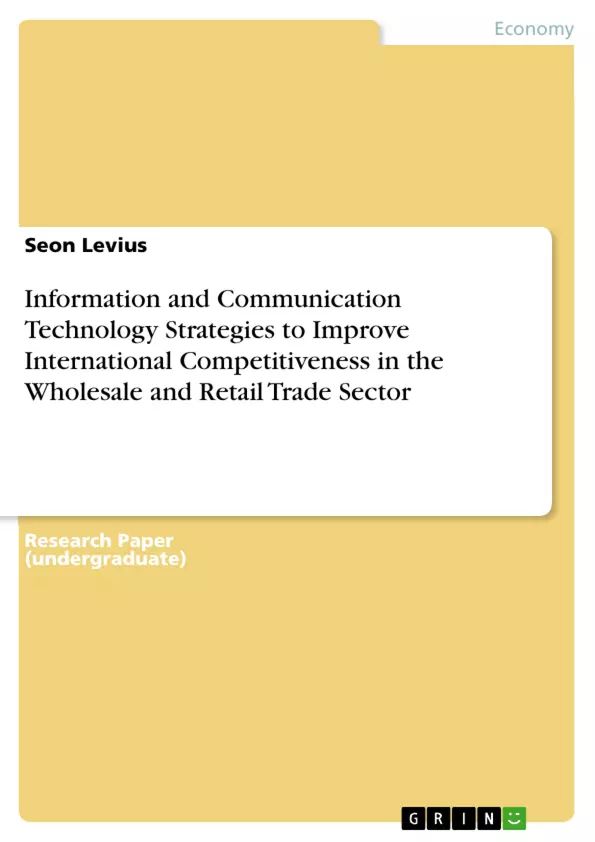The study explored the Information and Communication Technology (ICT) strategies that managers of Barbados's wholesale trade businesses use to improve international competitiveness in Barbados. The resource-based view theory was the conceptual framework for this study. Data collection included semi structured interviews with 15 business managers, participant observation, and organizational document analysis. Data analysis and methodological triangulation revealed 4 themes that helped to understand the findings within the context of the research question and the purpose of the study. These themes included competitive position and response, internal factors, IT-specific factors, and ICT experiences. Implications of social change include providing business managers with specific knowledge on ICT strategies used to improve international competitiveness in Barbados and an understanding of desirable and undesirable perspectives held regarding these strategies.
Inhaltsverzeichnis (Table of Contents)
- Introduction
- Purpose of the study
- Conceptual Framework
- A Review of the Professional and Academic Literature
- Geographical Context of the Study
- The Caribbean Environment: Small and Constrained
- Use of ICT in Wholesale and Retail Trade
- ICT Strategies Used in Wholesale and Retail Businesses
- Information Technology and Context
- Information Technology and Business Performance
- Use of RBV in Information System Research
- RBV Concepts
- The Role of Inhibitors
- Summary of Important Points
- Presentation of the Findings
- Summary of Findings ...
- Applications to Professional Practice
- Implications for Social Change ..
- Recommendations for Further Research
- Summary and Study Conclusions
- References ..
- ICT strategies for improving international competitiveness in the Barbadian wholesale and retail trade sector
- The resource-based view (RBV) theory as a framework for understanding ICT and competitive advantage
- The impact of globalization, trade liberalization, and changing international trade regulations on Caribbean businesses
- The role of ICT in mitigating the impact of regulatory changes and enhancing private sector competitiveness
- The importance of addressing undesirable actions through ICT strategies to improve the Barbadian economy and benefit its citizens.
Zielsetzung und Themenschwerpunkte (Objectives and Key Themes)
This qualitative single case study investigates the Information and Communication Technology (ICT) strategies employed by managers of Barbados's wholesale trade businesses to enhance their international competitiveness. The study draws upon the resource-based view (RBV) theory as its conceptual framework to understand the role of ICT in achieving sustainable competitive advantage. It aims to provide insights into specific ICT strategies for improving international competitiveness in the Barbadian wholesale and retail trade sector.
Zusammenfassung der Kapitel (Chapter Summaries)
The introduction highlights the challenges faced by Caribbean private sector businesses due to globalization, trade liberalization, and changing international trade regulations. It underscores the impact of the Economic Partnership Agreement (EPA) with the European Union (EU) on Barbados and CARIFORUM, necessitating the search for ways to enhance global competitiveness. The chapter further emphasizes the decline in international trade and increased competition experienced by Barbados's wholesale and retail trade sector since the signing of the EU EPA.
The purpose of the study is to explore the ICT strategies used by managers of Barbadian wholesale trade businesses to improve their international competitiveness. The study aims to provide insights into these strategies and their impact on the sector's overall competitiveness. It emphasizes the potential for social change through the implementation of effective ICT strategies that contribute to economic growth and benefit Barbadian citizens.
The conceptual framework of the study is based on the resource-based view (RBV) theory, which provides a lens for understanding how ICT can contribute to sustained organizational competitiveness. RBV theory posits that organizations can achieve a competitive advantage by leveraging valuable, rare, inimitable, and non-substitutable resources. The study explores the relevance of RBV in understanding the role of ICT in achieving sustainable competitive advantage.
The review of the professional and academic literature provides a geographical context for the study, focusing on the Caribbean region. It examines the characteristics of Small Island Developing States (SIDS) and the unique economic challenges they face, emphasizing the importance of ICT in promoting economic growth and development.
Schlüsselwörter (Keywords)
The key focus areas of this study are Information and Communication Technology (ICT), International Competitiveness, Wholesale and Retail Trade, Globalization, Organizational Environment, and Economic Partnership Agreement (EPA). The study examines the application of ICT strategies within the Barbadian context to address the challenges posed by globalization and changing trade regulations. It explores the potential of ICT to enhance organizational competitiveness and improve the economic landscape of Barbados.
- Citation du texte
- Seon Levius (Auteur), 2018, Information and Communication Technology Strategies to Improve International Competitiveness in the Wholesale and Retail Trade Sector, Munich, GRIN Verlag, https://www.grin.com/document/412619



